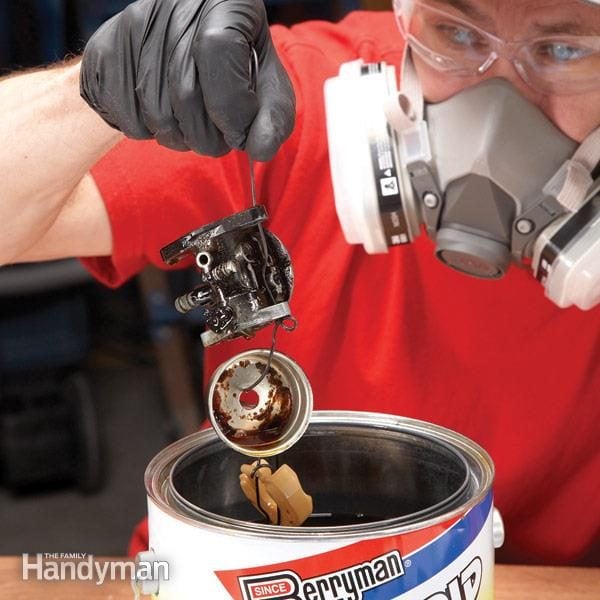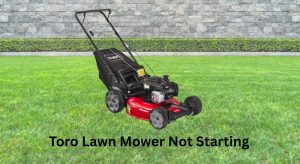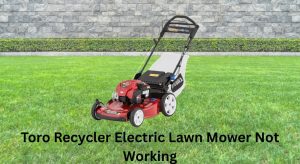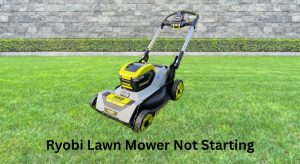Nothing’s more frustrating than when your lawn mower starts but does not stay running. You pull the cord or hit the starter, it fires—then sputters and dies. The fastest quick fix? Check and clean the air filter and carburetor bowl—most stalling issues are due to fuel/air delivery problems. A fresh spark plug and fresh fuel can also revive a stalling mower in minutes.
In this comprehensive guide, you’ll learn all the common causes and practical fixes, from simple checks to deeper carburetor cleaning. Whether you have a Honda, Briggs & Stratton, Kohler, or Toro engine, you’ll get multiple solutions, safety tips, and prevention strategies so your mower runs smoothly all season.
Common Causes of a Lawn Mower That Won’t Stay Running

- Stale or contaminated fuel (varnish, water in gas)
- Clogged carburetor jets, emulsion tube, or stuck float/needle
- Dirty or saturated air filter restricting airflow
- Bad or fouled spark plug, weak ignition coil, or poor connection
- Blocked fuel cap vent causing vacuum lock
- Fuel line blockage or cracked line letting in air
- Dirty or restricted fuel filter (inline or tank strainer)
- Governor or choke not operating correctly
- Low engine oil triggering safety shutdown (on some models)
- Debris under the mower restricting blade spin and causing stalling
- Faulty safety switches (seat, bail/handlebar, blade/OPC)
How to Fix a Lawn Mower That Starts But Doesn’t Stay Running

Method 1: Quick Checks and Easy Fixes (5–15 minutes)
Diagnosing the Issue
- Symptoms: Starts then dies in 3–10 seconds? Likely fuel starvation or choke issue.
- Dies when throttling up? Often carburetor main jet or air filter.
- Runs with choke on but dies with choke off? Lean mixture from clogged jets or air leaks.
Fix Steps
- Use fresh fuel
– Drain the tank and carburetor bowl if fuel is older than 30 days (or 90 days with stabilizer).
– Refill with fresh, ethanol-free fuel if available (E0 or E10 max 10% ethanol). - Inspect and clean/replace the air filter
– Foam filter: wash with warm soapy water, dry completely, lightly oil, squeeze out excess.
– Paper filter: tap gently to remove debris; replace if dirty or oil-soaked. - Check the spark plug
– Remove plug, inspect for carbon or wetness. Clean with a wire brush and set gap per engine spec (typically 0.028″–0.030″ / 0.7–0.8 mm).
– Replace if worn, cracked, or heavily fouled. Reconnect boot firmly. - Loosen/tighten gas cap
– Start the mower with the gas cap loosened half a turn. If it runs longer, the vent is blocked. Clean or replace the cap.
Testing
- Start the mower. If it runs consistently for a minute or more, you likely resolved a simple fuel/air issue.
- If it still dies, move to Method 2.
Method 2: Clean the Carburetor Bowl and Jet (20–40 minutes)
Most “starts then stalls” issues trace back to varnish or debris in the carburetor’s main jet or emulsion tube.
Safety Setup
- Work outdoors or in a well-ventilated space.
- Turn fuel valve OFF if equipped; otherwise clamp the fuel line.
- Disconnect spark plug wire to prevent accidental start.
- Have rags, carb cleaner, and a small container ready.
Tools/Materials
- Carburetor cleaner spray
- 10 mm or 1/2″ wrench/socket (common bowl nut size)
- Small wire (e.g., bread tie wire with plastic removed), sewing needle, or torch tip cleaner
- Screwdrivers, pliers
- New carburetor bowl gasket if needed
Fix Steps
- Remove the carburetor bowl
– Place a rag under the carb. Remove the single bowl nut (often the main jet).
– Carefully lower the bowl; note gasket orientation. - Clean the bowl and jet
– Empty fuel, wipe out sediment or water.
– Inspect the bowl nut: Many designs have tiny side holes and a center orifice—this is the main jet.
– Use wire/needle to gently clear all tiny holes. Do not enlarge them.
– Spray carb cleaner through the nut/jet until it flows freely. - Inspect float and needle
– Push the float up and down to ensure free movement.
– If stuck, spray cleaner at the needle/seat area. Do not scratch the seat. - Reassemble
– Refit the bowl with a good gasket. Tighten the bowl nut snugly (do not overtighten).
– Turn fuel valve on or unclamp line. Check for leaks.
Testing
- Reconnect spark plug. Start the mower.
- If it now runs with choke off and maintains idle and throttle, you’re done.
- If it still stalls, proceed to a deeper carb clean or fuel system checks.
Method 3: Full Carburetor Cleaning or Replacement (40–90 minutes)
If your mower runs only with choke or still dies, the emulsion tube, idle circuit, or internal passages are clogged.
Diagnosing the Issue
- Runs only with partial choke: mixture is lean (air leak or clogged jets).
- Surges (revving up/down): partially clogged main jet or air leak.
- Dies when engaging blade: mixture too lean or governor not responding.
Fix Steps
- Remove the carburetor
– Shut off fuel and disconnect spark plug.
– Remove air filter housing and linkages (note spring locations or take photos).
– Disconnect fuel line and catch residual fuel. - Disassemble
– Remove bowl, float, and needle.
– Remove the main jet and emulsion tube (inserted from below; gently push out if needed).
– Remove idle jet/mixture screws if accessible (count turns to lightly seated first). - Clean thoroughly
– Spray carb cleaner through all passages until it exits other ports.
– Use compressed air to blow out circuits (wear eye protection).
– Use tip cleaners or fine wire only to clear jets—avoid enlarging. -
Reassemble and reinstall
– Refit all parts in reverse order with new gaskets if available.
– Reconnect linkages exactly as photographed.
– Turn on fuel, check for leaks. -
Consider replacement
– Aftermarket carburetors for common engines (Briggs & Stratton 450e/500e/675EXi, Honda GCV160/GCV170, Kohler XT) often cost $15–$35 and save time. Match by engine model/type.
Testing
- Start and warm up 2–3 minutes. Try varying throttle and engaging the blade.
- If it holds steady, you’ve fixed the fuel system restriction.
Method 4: Fuel System and Air/Vacuum Checks (15–30 minutes)
Diagnosing the Issue
- Stalling after 30–60 seconds can indicate slow fuel delivery or vacuum lock.
Fix Steps
- Check fuel cap vent
– Confirm the cap allows airflow. Replace if clogged. - Inspect fuel line and filter
– Look for kinks, cracks (air leaks), or internal collapse.
– Replace brittle lines. Install/replace inline fuel filter in the correct flow direction. - Drain water/contaminants
– Water in fuel sinks to the carb bowl. Drain tank and bowl, refill with fresh gas. - Check for intake air leaks
– Spray carb cleaner around the carb-to-intake gasket and intake-to-head while idling. Engine speed change indicates a leak. Replace gaskets or tighten fasteners.
Testing
- Run the mower for 5–10 minutes to confirm stable operation.
Method 5: Ignition, Governor, and Safety Systems (15–45 minutes)
If fuel/air systems check out, look at spark and controls.
Diagnosing the Issue
- Intermittent spark causes random stalling.
- Faulty operator presence control (OPC) cable/bail can cut ignition.
- Governor/choke linkages out of place can mismanage air-fuel.
Fix Steps
- Spark and coil
– Test spark with an inline spark tester. Consistent bright spark is required.
– Replace the spark plug first (cheap and common fix).
– If no/weak spark when hot, the ignition coil may be failing. Replace and set air gap per spec (often 0.010″–0.014″). - Safety switches and cables
– Ensure the handlebar/bail lever fully retracts the kill switch and engages the engine brake properly.
– Adjust or replace stretched OPC cable. - Choke and governor linkages
– Verify choke plate opens fully after start and closes for cold start.
– Check governor spring/linkages for correct tension and placement. - Low oil shutdown (on some engines)
– Check oil level and top up with SAE 30 or 10W-30 per manual. Some engines won’t run if oil is low or excessively tilted.
Testing
- Start, warm up, and mow a test strip. If it still stalls, revisit carburetion or consider professional diagnosis.
How to Prevent Future Stalling
- Use fresh gasoline and add fuel stabilizer if storing more than 30 days.
- Run the carb bowl dry before seasonal storage or use the fuel shutoff.
- Replace air filter and spark plug annually or per the manual.
- Keep deck clean to reduce engine load; sharpen blade each season.
- Service the carburetor each spring if you use ethanol-blended fuel.
- Store the mower level, indoors, and away from moisture.
Pro Tips
- Use ethanol-free gas (E0) when possible; it reduces varnish and moisture issues.
- If the mower surges, slightly enrich by cleaning the main jet again—surging is the classic lean symptom.
- Mark linkage positions with a paint pen before removal to ensure exact reassembly.
- Keep a $15 aftermarket carb on hand during peak mowing season for instant swap repairs.
- Replace primer bulbs that are cracked or sticky; they can prevent proper fuel priming.
- Don’t overtighten the carb bowl nut—this crushes the gasket and causes leaks/air entry.
- After a full carb clean, let the engine run for 10 minutes under light load to clear residual moisture.
When to Call a Professional
- You’ve cleaned/replaced the carb and it still stalls.
- Spark tests strong, fuel flows freely, but stalling persists—possible valve, compression, or governor issues.
- The engine dies under load with unusual noises, smoke, or backfiring.
- You’re uncomfortable with fuel or ignition work.
What to look for:
– Small engine technician with certifications (e.g., Briggs & Stratton Master Service).
– Transparent estimates and warranty on parts/labor.
– Access to OEM parts and service bulletins.
Typical cost ranges:
– Carburetor cleaning: $60–$120
– Carburetor replacement/tune: $80–$150
– Ignition coil replacement: $60–$130
– Full tune-up (plug, filter, oil, blade sharpen): $80–$150
Warranty considerations:
– Newer mowers may have engine warranties; DIY carb disassembly usually doesn’t void warranty, but modifications might—check your documentation.
FAQ
Q: My mower starts only with choke and dies when I open the choke. Why?
A: That’s a lean condition—typically a clogged main jet/emulsion tube or an air leak. Clean the carb’s jets and check intake gaskets. Ensure the air filter isn’t missing, which can also cause a lean mix.
Q: Can bad gas really cause my mower to start then die?
A: Yes. Ethanol-blended fuel absorbs moisture and forms varnish that clogs jets. If fuel is older than 30 days without stabilizer, drain and replace it. Clean the carb bowl and jet afterward.
Q: How do I know if the gas cap vent is the problem?
A: Loosen the cap slightly and start the mower. If it runs normally, the vent is blocked and creating vacuum in the tank. Clean or replace the cap.
Q: It runs for a minute, then dies. Fuel issue or ignition?
A: Often fuel flow. Check for restricted fuel filter/line, water in the bowl, or a sticking float. If it dies hot and restarts only after cooling, suspect the ignition coil.
Q: What spark plug should I use?
A: Match the engine model. Common options: NGK BPR6ES or BR2LM for many Briggs, NGK BPR5ES for some Honda GCV, Champion RJ19LM for older models. Verify gap and spec in your engine manual.
Q: Do I need to replace the carburetor or just clean it?
A: Try cleaning first. If corrosion is heavy, the emulsion tube is seized, or gaskets are brittle, replacing the carb is often faster and cost-effective.
Q: Why does my mower stall when I engage the blade?
A: Likely a lean condition, dull blade overloading the engine, or clogged deck. Sharpen the blade, clean the underside, and ensure the governor responds. Also check that the belt/blade brake isn’t dragging (for self-propelled/tractor types).
Alternative Solutions
If repeated carb issues persist, consider these options:
| Solution | Pros | Cons | Best For |
|---|---|---|---|
| Ethanol-free fuel (E0) | Reduces varnish/moisture, longer storage life | Higher cost, less availability | Seasonal users |
| Inline fuel shutoff + run bowl dry | Keeps carb clean during storage | Extra step after each mow | Infrequent mowing |
| OEM carburetor replacement | Reliable fit and performance | Higher cost than aftermarket | Long-term reliability |
| Aftermarket carb kit | Low cost, fast swap | Variable quality | Quick fixes, budget repairs |
Get Your Lawn Mower Running Again
Following this guide, you now have multiple solutions to fix a lawn mower that starts but does not stay running:
– Quick checks: fresh fuel, air filter, spark plug, and gas cap vent
– Carburetor bowl cleaning and main jet clearing
– Full carburetor cleaning or replacement
– Fuel line, filter, and intake leak checks
– Ignition coil, choke, governor, and safety switch diagnostics
Don’t let a stalling mower derail your weekend. Work through these methods in order, and you’ll restore reliable performance and prevent future issues with simple maintenance habits.
Have you fixed your mower with one of these steps? Share what worked in the comments to help other readers. Found this helpful? Bookmark it for the next tune-up. With the right approach, your mower will run smoothly from the first pull to the last pass.





